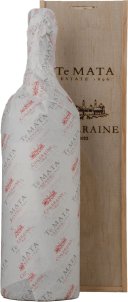CHATEAU SMITH-HAUT-LAFITTE Rouge Grand cru classe
Dating back over 800 years in the Bordeaux region, Chateau Smith Haut Lafitte is owned today by Daniel and Florence Cathiard. The estate also features a world class spa, which specialises in Vinotherapie - using grape extracts in many of their treatments. Up until the year 2000, the estate was not known for producing top quality wines, however in the capable hands of the Cathiard family and after over a decade of hard work and reinvention, the wines truly began to come into their own. It has been, in the words of Andrew Caillard, an astonishing ascendancy in the past 15 years, and given the sterling reviews the 2016 vintage has received, its trajectory seems set to continue its meteoric rise.
Chateau Rauzan-Segla 2me cru classe
One of the original Second Growths of the Bordeaux Classification of 1855, Rauzan-Ségla's 51 hectares of mineral rich soils begin on the banks of the Gironde, on the left bank of Bordeaux. A complex mix of gravel, clay and limestone subsoil imparts a richness and complexity to the Cabernet (62%), Merlot (36%), Cabernet Franc (1%) and Petit Verdot (1%) grapes used to produce this powerfully intense and elegant wine. The estate was last sold in 1994 to the Wertheimer family of Chanel, who employed former Château Latour winemakers, David Orr and John Kolasa. Nicolas Audebert, the former winemaker at Cheval des Andes, the LVMH property in Mendoza Argentina, was hired to succeed John Kolasa following his retirement in 2014.
Te Mata Estate Coleraine Cabernet Merlot
Te Matas Hawkes Bay estate is a prestigious winery with a rich history, producing some of New Zealands most celebrated wines. If the Langtons Classification crossed the Tasman, Te Mata Coleraine would sit alongside Grange at its very pinnacle. Established, esteemed, outstanding vintage after vintage, the glowing adjectives come thick and fast.
Chateau Figeac 1er grand cru classe
While a fair share of Bordeaux vineyards can claim significant historical pedigree, few would be able to touch Chateau Figeac - it is one of a select few St Emilion vineyards to have been continuously occupied for over 2,000 years! The estate dates back to the second century when even the ancient Romans who occupied the area were aware of its outstanding terroir. One figure dominates the Chateaus modern era, and that is Thierry Manoncourt who ran the property from 1947 until his death in 2010, just shy of his 93rd birthday. Under his leadership, the Chateau was the first major Right Bank estate to embrace modern techniques such as temperature controlled, stainless steel vats. The traditional-styled Bordeaux has, understandably, gone through a wide range of iterations in its 2,000-plus year history - yet it still manages to surprise and delight. The 2016 earned rave reviews from critics, with Jancis Robinson hailing it as a wine of which ...the Manoncourt family should be very proud.
Chateau Calon-Segur 3me cru classe
With its name enclosed in a heart on the label, Chateau Calon-Ségur is a third-growth estate (3ème Cru Classé) in Saint-Estèphe. Firm and sturdy in style, Chateau Calon-Ségur is somewhat austere in its youth, possessing a prominent tannin structure that rewards extended cellaring over 10 to 20 years.
Chateau Mouton-Rothschild, 1er Cru Classe Aile D'Argent Blanc
Château Mouton-Rothschilds dry Bordeaux white is made from a blend of Sauvignon Blanc, Semillon and Muscadelle, all planted within 4.5 hectares of vines. It is one of the few Bordeaux whites that is subject to malolactic fermentation. Ripe, intense, and elegant, stone fruit and citrus dominate the palate of this wine, with a line of racy acidity to add freshness.
Sena Cabernet Merlot Carmenere, Aconcagua Valley, Chile
Chiles answer to first growth Bordeaux, Viña Seña is one of the countrys most sought after wines. In his reviews and commentary on the wine, James Suckling has played a significant role in highlighting Viña Señas credentials as world-class. While comparisons to Mouton Rothschild or Harlan can and have (again, Suckling) been made, one of the more interesting features of this wine is how well it drinks when young. For a Cabernet-based blend in this class, Viña Seña leaps out of the gate showing cassis and fresh blueberries. This is altogether very gratifying but theres so much more in store. The length, depth and breadth make this a great working example of what we mean when we talk about three-dimensionality. High-wire act acidity and strong-man fruit, this circus of sensory pleasure is even more appealing considering that for the price of one Bordeaux first growth, youll have six of these. Hedonists take note.
Chateau Croix de Labrie Grand Cru
Château Brane-Cantenac Margaux
Château Brane-Cantenac sits in a prime position on the plateau of Cantenac and makes full use of its excellent terroir. No doubt something that Baron de Brane was aware of and along with his viticultural talents were the reasons behind the estates rise to fame. Now tended by the Lurton family, the wines continue to be in great hands. Of the 2009 vintage, Henri Lurton is known to have said that the winery was enveloped in aromas of raspberry and blackberry even before fermentation began! Even though fruit ripeness is an obvious trait, the balance and structure of the wine are also clearly evident which will see the wine age for a decade or two more.
Château Climens Sauternes-Barsac
Château Climens dessert whites are known for elegance, purity and freshness. The stellar 1986 vintage has lead to a remarkably rich and defined wine, one that showcases why Climens is regarded by many as the regions best wine after Yquem. Although it is slightly unfair to compare them due to their inherent differences in style and approach.















